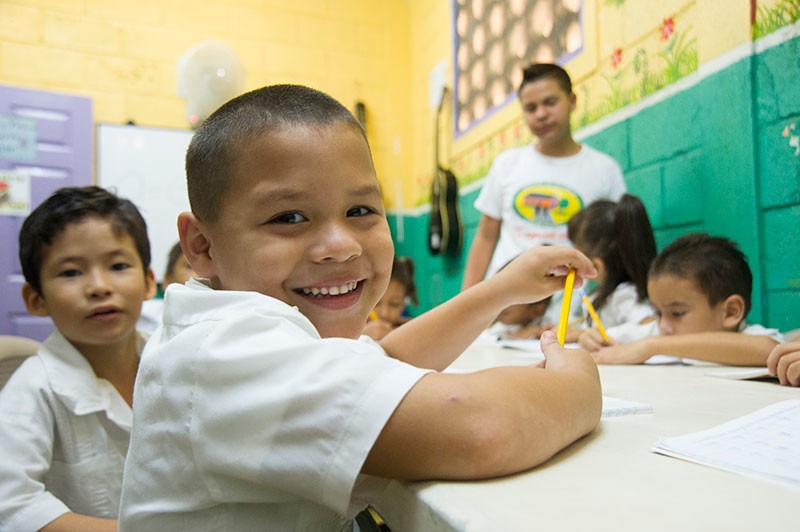Finding new ways to foster civic engagement among young people, particularly from at-risk and marginalized populations, builds youth resiliency and strengthens communities, experts said at the Comparative and International Education Society’s 2018 Conference.
Presenters on the March 26 panel, “Speaking Up: Educating for Civic Purpose on Both Sides of the Wall,” outlined case studies on the value of civic purpose for young people, drawing from on-the-ground experience implementing development programs in Honduras, Guatemala and the Philippines.
Presenting panelists, despite the differences in their programs and country contexts, agreed that while civic education is important, the idea of civic engagement has evolved – and should continue evolving – outside of schools.
Panel chair Jeff Coupe, Senior Associate for the Education in Conflict Practice Area at Creative Associates International, stressed that youth need an enabling and just learning environment, supportive staff and peers and transformative leadership to allow civic engagement to flourish.
“Civic learning takes place in multiple contexts and there are new approaches to civic learning that are more active and student-centered,” Coupe said. “We need to believe in these kids to give them the opportunities to develop their competencies and sense of civic purpose in working to effect change beyond themselves.”

A volunteer teaches spelling to a group of children at an Outreach Center in San Pedro Sula. Photo by David Snyder.
Reaching youth outside of schools
Salvador Stadthagen, Senior Associate for Creative’s Citizen Security Practice Area, presented a case study of the USAID-funded Alianza Joven Honduras (Youth Alliance Honduras), a five-year violence prevention project that ended in 2017 and for which he served as Chief of Party.
Alianza Joven established a network of 65 Outreach Centers in seven high-violence cities, creating safe spaces for youth to do schoolwork, spend free time, get involved in group activities, learn vocational skills and set goals for their futures. Alianza Joven encouraged youth to work as volunteers to staff the centers and support their peers and younger children. Over the life of the project, about 2,000 youth volunteered their time at the centers.
“The base and the true spirit of the Outreach Centers is volunteerism, because it unleashes the power of the community and the power of youth,” Stadthagen remarked. “These are youth helping other youth, and that is very powerful.”
Stadthagen noted the importance of not only getting youth engaged, but also recognizing and rewarding their accomplishments and the skills they develop through volunteerism, which can build positive self-image and give potential employers proof of a certain skillset.
Amplifying youth voices
Each panelist discussed the importance of elevating youth voices through civic engagement in different ways. In Honduras and elsewhere in Central America, the growing Youth Against Violence movement has given young people a platform to advocate for themselves, said Stadthagen.
In the Philippines, the five-year USAID-funded Mindanao Youth for Development, or MYDev, project seeks to strengthen local governance increase access to technical and vocational training, while also building resilience to violent extremism and encouraging community engagement among 25,000 out-of-school youth in high-risk communities.
Kevin Corbin, Senior Technical Advisor for the Education Development Center, explained that the project’s Out-of-School Youth Development Alliances, which comprise local government actors and other stakeholder groups, give youth a seat at the table with elected youth representatives. In addition, these alliances also search for opportunities for youth to participate in community service work.
“At the end of the modules, young people are really activated, getting involved in their community,” he said. “This is something that these Out-of-School Youth Development Alliances identify is a menu of civic engagement activities that young people can get involved in, linking training to civic activities.”

Youth seeking restorative justice
In Guatemala, the Population Council is working to enable young women to serve their peers through the Abriendo Oportunidades (Opening Opportunities) project, which empowers young Mayan girls and women, in part through peer-to-peer mentorship.
Alejandra Colom, Country Director for the Population Council, explained that as the project seeks to address some of the long-lasting effects of the Guatemalan armed conflict, specifically violence against women and girls, they discovered that many young women had little knowledge of the civil war, even as women and girls continue to face similar types of violence post-conflict.
Abriendo Oportunidades educates its mentors about the war and what their mothers, grandmothers and great-grandmothers’ generations experienced. With that knowledge, young women are seeking restorative justice, either through formal routes or through traditional justice channels found within Mayan communities.
“We do believe strongly that agency is an important component or outcome of our program. We want girls and adolescents to feel empowered to denounce, challenge and de-normalize violence against women and girls in their communities,” Colom said. “We also think strength in numbers will help them change social norms and allow them to push for restorative justice whenever violence is incurred against them.”
In Guatemala, Honduras and the Philippines, creating opportunities for youth to become civically engaged not only benefits them as individuals, but also promotes the prevention of violence in various forms.
Creative’s Coupe said that when individuals are given these opportunities as youth, they can become change agents as adults.
“Through this invitation to participate in civic life, we hope students will become civically engaged after adolescence and into early adulthood, and hopefully this will be a transformative experience not just for themselves but for the communities in which they work,” he said. “We hope that they are actually taking a leadership role in making change possible.”
Attending CIES?
To visit Creative’s CIES 2018 Special Report hub, click here .For a full schedule of Creative’s CIES 2018 panels, including panelists, times and locations, click here. In addition to the panel sessions, stop by booth 54 to engage with education experts and to learn more about Creative’s global projects. Follow us on Twitter @1977Creative for live updates.